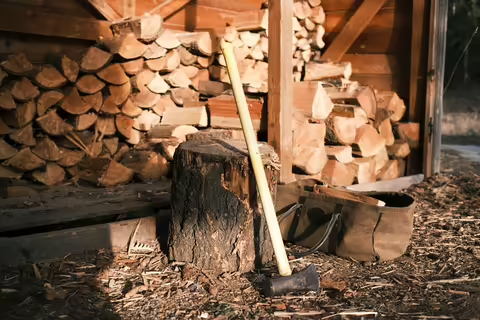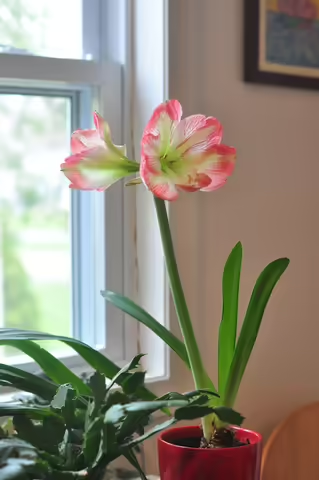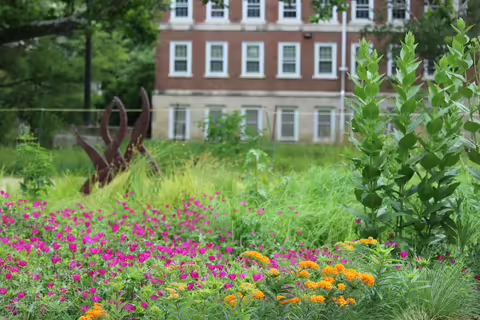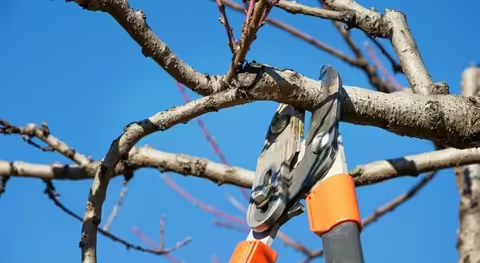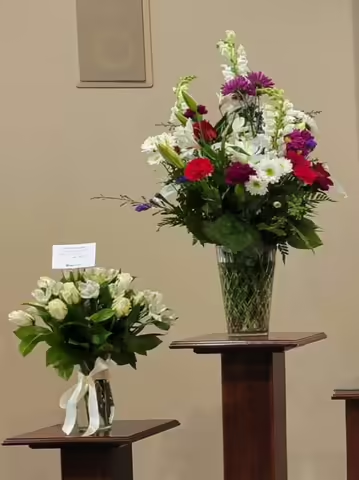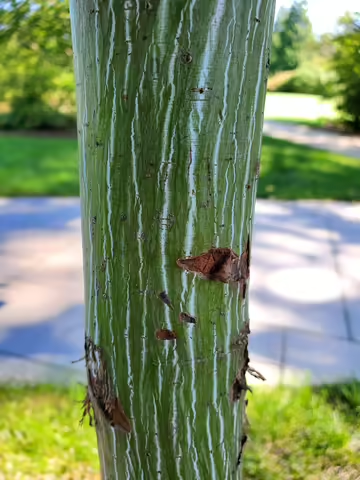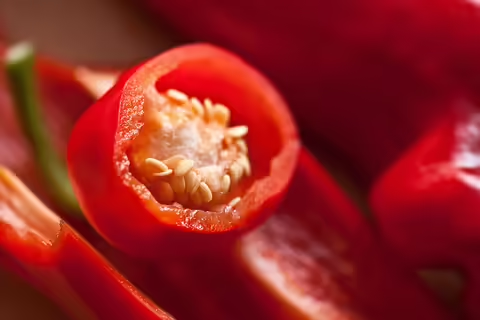Protect trees from winter’s wrath with a few preventive steps
By Sarah Vogel
Winter is hard on trees. Wind, ice, and cold temperatures can harm trees through sunscald, branch-breaking ice loads, or winter burn on evergreens. Taking preventative measures in the fall can help minimize winter injury to trees in the landscape.
Winter injury on evergreens
Boxwood, arborvitae, and other evergreen species have leaves and needles that transpire water all year long, even in winter. When water exits the plant faster than it is absorbed, winter burn occurs in desiccated needle and leaf tissue. Water loss happens more quickly in windy or sunny conditions, even in low temperatures. Without wind protection, more damage may be noticed on the windward side of the plant, typically the south or southwest.
When autumn doesn’t provide adequate rainfall, deep watering before winter increases moisture to the roots before the ground freezes. Provide water during brief thawing on warmer days in winter to further lessen winter burn. A ring of mulch around the base of the plant provides a layer of insulation that helps maintain moisture, reduce drastic soil temp fluctuations, and prevent frost heaving. Mulch should stay a few inches away from the trunk.
Burlap or canvas windbreaks may reduce injury from wind, however, if injury is sustained year after year this greatly impacts the overall health of a plant, and different species may be considered for the site. High levels of stress, such as repeated winter injury, increase susceptibility to biotic pests and pathogens. Anti-desiccant sprays help retain moisture and protect plants from some fungal diseases. Prune away any damaged tissue before new growth emerges in spring.
Sunscald and frost cracking
Frost cracking occurs when the sun warms bark and outer wood, causing it to expand. In the absence of sunlight, temps cool, and that same tissue will contract. These sudden temperature fluctuations result in vertical fractures along the trunk, called frost cracks.
Sunscald is a result of the same conditions, but causes a different type of damage. Tree cells enter dormancy during winter months. Dormancy can be disrupted by direct sunlight warming cells, only for temps to drop again and kill tree cells.
These phenomena occur in young, thin-barked species such as maple, ash, linden, apple, and peach. Young trees with no barrier from elements are more susceptible. Providing adequate water through fall and winter will help prevent sunscald
Planting trees where they will be protected from the late afternoon sun helps to prevent sunscald and frost cracking. If using tree wrap, apply wraps in November and be sure to remove them in April. Leaving wraps on all year can cause damage or restrict growth.
Broken branches
Winter often brings snow, ice, and high winds. Removing snow loads by shaking branches is not recommended. In fact, it can lead to further damage in frozen, brittle branches. Gently remove snow by using a broom and sweeping upward, but do not stand under the branch. It is best to wait for a warmer day or until ice melts.
Some trees are more susceptible to broken branches in winter conditions, like multi-stem trees, upright evergreens, and especially trees with included bark from co-dominant stems or narrow branch angles. Prevent storm damage before the risk of breakage is present by pruning deciduous trees while they are young. Remove codominant stems and promote an appropriate scaffolding structure. Avoid pruning late in summer as it promotes new growth that cannot harden off before winter. This can lead to frost damage dieback on branch tips.
If branches break in young trees during a storm, prune them back to the main branch or trunk. Seek help from tree care professionals to prune limbs of larger trees.
Trees are a large part of any landscape and keeping them healthy by using good cultural practices is the best preventative measure against pests, pathogens, and natural disasters. Use these methods to prevent winter damage and protect the health of your trees. For more information, review this Trees and winter storm damage article.
For more research-based information on tree care, connect with your local Illinois Extension county office at go.illinois.edu/ExtensionOffice.
Sarah Vogel is an Illinois Extension horticulture educator for DeWitt, Macon, and Piatt Counties. Gardeners Corner is a quarterly newsletter from gardening experts around the state. Each issue highlights best practices that will make your houseplants, landscape, or garden shine in any season. Join the Gardener’s Corner email list at go.illinois.edu/GCsubscribe for direct access to timely tips.
Indoor gardening can brighten winter doldrums
By Mary Fischer
Dreading the long cold months of winter? Create a green space indoors with plants.
Historically, plants have been used for their medicinal properties. Growing movements like horticulture therapy use plants for their healing properties, individual health, and well-being.
We can engage with plants actively, by pruning or watering, or passively, by enjoying the sight or scent of a plant or flower. This is especially beneficial to those with limited mobility or limited communication skills. Research has shown that both active and passive interactions with plants and gardening experiences can have a pronounced positive effect on physical and psychological functioning.
How to bring the outdoor plants inside?
To build an indoor garden, select plants to bring indoors or purchase some new plants. Early fall is the best time to move plants from outside to indoors, and there are a few things to consider for a smooth transition.
- Monitor the temperature: Move houseplants inside before night-time temperatures gets below 45°F.
- Watch out for hitchhikers. Before moving houseplants indoors, check leaves, stems, and soil thoroughly for pest problems. Common pests are aphids, scale, mealybugs, and spider mites. Spray any pests with insecticidal soap. Give plants a good wash with a strong spray of water to dislodge any undetected hitchhikers.
- Time to acclimate: Slowly acclimate plants to lower light levels by placing them in shaded areas for a couple of weeks before the transition to indoors. This is also a good time to trim overgrown plants and remove any dead leaves.
- Reduce watering and fertilizing: Plants need a period to rest from growth and flowering. During colder months the need for water and fertilizer is lower. Provide enough water so that the plants do not dry out completely.
- Provide light and humidity: Bright, indirect light is necessary. Remember, photosynthesis is how the plant makes food. If an area is darker, consider adding grow lights. As heated homes typically have dry air, use a humidifier or mist plants daily to keep leaf tips from turning brown.
Once plants have been successfully transitioned indoors the most important factor in creating a relaxing atmosphere using plants as a backdrop is you.
Tropicals
Tropical plants make excellent indoor plants as they stay green through the winter. These plants can be used to create terrariums or teacup gardens. Propagation of tropical plants is a perfect activity for self-reflection and goal setting as plants have roots that may open the door to help an individual grow new roots in their lives. Create a simple propagation chamber using a zippered bag to provide a humid environment to support the plants in creating new roots.
Spider plants, Christmas cacti, and peperomia are easy plant propagation selections.
Get Crafty
For crafty individuals, try using spent flower and even leaves to make paper. Other ideas include forcing bulbs like paperwhite bulbs, tulips or amaryllis indoors. Use last year’s gourds to create beautifully painted birdhouses for the spring arrivals, make scented pinecones or gumballs with a favorite essential oil.
Plan next season’s garden
Decide what should be planted or what plants you want to harvest. Two excellent resources are newly released All America Selections award winners for the upcoming year and Proven Winners selections. Keep a journal of pictures of favorite plants and new seed introductions from seed catalogs. Try something new! Research and plan a themed garden such as a sensory garden or a moonlight garden. It is also a good time to think about ordering seeds for the upcoming gardening season. Read seed package labels to determine when and how to start seeds indoors. Each year try a new variety or color to add interest.
For more research-based information on plant care, connect with your local Illinois Extension county office at go.illinois.edu/ExtensionOffice.
Mary Fischer is an Illinois Extension horticulture educator for Clay, Effingham, Fayette, and Jasper counties. Gardeners Corner is a quarterly newsletter from gardening experts around the state. Each issue highlights best practices that will make your houseplants, landscape, or garden shine in any season. Join the Gardener’s Corner email list at go.illinois.edu/GCsubscribe for direct access to timely tips.
Burning local firewood this winter can save forests
By Ryan Pankau
Nothing beats the warmth of a crackling fireplace on these coldest days of the year. Each winter, as my family enjoys the cozy warmth of our woodstove room, I’m always thankful for the firewood supply we’ve been fortunate enough to accumulate.
Most of the wood we burn comes from sources very near to our house, but from time to time we’ve purchased firewood from others. When we do, I’m always very picky about the wood we bring to our property. Some of this pickiness is based on tree species since certain species burn much hotter than others, but most of my concern centers on the location this wood came from prior to being stacked in our woodshed.
Don’t move firewood
Moving firewood has become one of the major pathways for invasive insects to reach new areas. Many of these pests are transported right along with the wood since they use trees for all or part of their life cycle. It has become a growing problem in recent years, resulting in major outreach efforts by the U.S. Department of Agriculture, state agencies, and others who are concerned about the impacts to our urban and natural forests from these damaging, non-native pests.
Emerald Ash Borer (EAB)
The emerald ash borer (Agrilus planipennis) has been one of the most significant firewood hitchhikers in recent history. This non-native insect is virtually eliminating native ash trees from forests across the eastern U.S. as larvae feed on and kill trees. With plentiful dead ash trees in its wake, there is no shortage of firewood and larvae often hitch a ride along with transported wood.
As researchers have looked at natural dispersal rates of EAB compared to human-aided dispersion, it has become abundantly clear that human movement of ash has greatly increased the rate of spread. This pest was first identified in Detroit in 2002 and has since spread to Northern Illinois in 2006 and downstate. Currently, it is believed to be present in all Illinois counties and fully confirmed in most. This rate of spread could not have occurred without human help.
EAB and Quarantines
Prior to EAB arrival in Illinois, the movement of ash firewood was restricted based on both state and federal quarantine requirements. As it approached our borders, officials closely monitored the spread of EAB, systematically applying county-level firewood quarantines to limit its spread. In 2015, EAB was so widespread across Illinois that state quarantines were lifted. However, federal quarantines remained in place, restricting firewood distribution across state lines, until January 2020 when those requirements were lifted as well. Today, all efforts toward EAB at the federal level are now focused on mitigation and control of this pest, as opposed to outreach related to ash firewood movement.
Although EAB-related restrictions have been lifted, there is still concern with the movement of firewood in Illinois. Specifically, the spongy moth (Lymantria dispar) has spurred quarantines for eight counties in northeastern Illinois since its first detection in 2006. This pest is less host-specific and its egg masses may be spread by firewood from a wide range of species, not just ash. Fortunately, the Illinois Department of Agriculture is very active in both monitoring and control of this pest which has greatly reduced its spread. However, the potential for new infestations in other areas remains if firewood from these northern counties is transported out of the quarantine area.
You can stop the spread
All of us need to be aware of where we transport firewood and where we source our own supply. Beyond the insect pests mentioned here, there are diseases that can inadvertently be brought to Illinois on firewood as well. It is difficult to predict where the next threat may come from and limiting human distribution via firewood is an important part of stopping the spread of invasive species to our state and others.
For more research-based information on invasive species, visit go.illinois.edu/invasive or connect with your local Illinois Extension county office at go.illinois.edu/ExtensionOffice. Explore resources for firewood at extension.illinois.edu/firewood.
Ryan Pankau is an Illinois Extension horticulture educator for Champaign, Ford, Iroquois, and Vermilion counties. Gardeners Corner is a quarterly newsletter from gardening experts around the state. Each issue highlights best practices that will make your houseplants, landscape, or garden shine in any season. Join the Gardener’s Corner email list at go.illinois.edu/GCsubscribe for direct access to timely tips.
Give someone a green holiday season with the gift of plants
By Brittnay Haag
If picking the perfect holiday gift stresses you out, this year visit your local garden center for a natural gift that keeps on giving. Gardening and growing plants is an experiential gift that is both rewarding and fun.
If you are gifting a plant this season, remember to keep your gift recipient in mind. Do they have pets or small children who will disturb the plants? Some plants may be toxic, too. How much space and sunlight do they have? Would they prefer to receive a plant to have for years, or will they most likely discard it after the holidays? With all of this in mind, there is a perfect plant for everyone.
Poinsettias
Poinsettias are the traditional holiday plant, but new varieties with interesting flower shapes, sizes, and colors are introduced every year. They grow best in bright, indirect sunlight and away from any draughts. Poinsettia roots easily rot if they are oversaturated, so only water plants when the soil surface feels dry. A native to Mexico, the Poinsettia does not tolerate cold temperatures. Make sure to protect the plant if transporting it outside to another location.
Amaryllis
An amaryllis kit will transform into multiple showy, bell-shaped blooms atop a 1-foot green stalk, and will include everything you need to force these flowering bulbs inside. Forcing bulbs indoors is a simple gardening technique that imitates the natural environmental conditions and tricks the bulb into flowering inside instead of out in the garden. Amaryllis flowers can be found in many colors including red, white, peach, pink, and variegated.
Christmas cacti faithfully bloom every year in December, with frilly flowers of white, pink, or red covering the flat, cactus-like foliage. They are short-day plants, meaning that flower development is initiated by long, dark, cool nights that occur in winter. These plants are one of the easiest to care for. They are also easy to propagate and make new plants.
Rosemary
A rosemary topiary is a perfect gift for anyone who loves to cook with fresh ingredients. The fragrant foliage of the rosemary plant can be trimmed into different shapes and placed in a brightly lit area. The potted plant can also be transplanted into the garden in the spring. Don’t forget to bring it back inside in the fall though.
Other botanical gifts
Other botanical gift ideas include unique houseplants or miniature evergreens delightfully decorated with ornaments and ribbon for the holiday season, fresh mistletoe adorned with a bow to tie above a doorway, glossy green holly with bright red berries filling a vase, or an air plant ornament to hang as decoration.
The gift of gardening is an experience that anyone can appreciate this holiday season. Instead of more “stuff,” consider an environmentally friendly gift this year. Give someone a green holiday season.
Brittnay Haag is an Illinois Extension horticulture educator for Livingston, McLean, and Woodford counties. Gardeners Corner is a quarterly newsletter from gardening experts around the state. Each issue highlights best practices that will make your houseplants, landscape, or garden shine in any season. Join the Gardener’s Corner email list at go.illinois.edu/GCsubscribe for direct access to timely tips.
Planning a new perennial garden? Plant for the whole garden ecosystem
By Layne Knoche
Welcome to winter. The days are short and cold, and if you enjoy plants like I do, hopefully, you have a few indoors to boost your mood. However, there is already light on the horizon. Spring will be here before you know it, and now is a wonderful time to plan out your new perennial gardens.
The days of planting individual plants and surrounding them in a traditional sea of mulch or rock are numbered. Instead, a design paradigm described in the book “Planting in a Post-Wild World” by Thomas Rainer and Claudia West is one that gardeners are flocking to. The innovative approach incorporates the concept of functional layers that form a complex yet organized landscape that reflects nature.
We need aesthetically beautiful gardens that also provide multiple ecosystem services such as water filtration and insect habitat. You cannot get that from most traditional landscapes. This design method works. We have used it successfully and beautifully at the Red Oak Rain Garden on the campus of University of Illinois in Urbana-Champaign and I have even used it in my own gardens.
Design in Layers
Be aware of layers when designing perennial gardens. Each layer has a selection of plant species that perform a specific function. When designing, it’s best to focus on these three layers: Groundcover, structural, and seasonal.
The Groundcover Layer
This layer typically consists of low-growing, densely planted grasses, sedges, ferns, and forbs that form a “green mulch” that serves to shade out weeds. Depending on the species chosen, these may be planted in groups of 10 or more and planted as little as 12 inches apart. As they fill in and mature, they protect from soil erosion, provide habitat for overwintering pollinators, and much more.
The Structural Layer
This layer consists of trees, larger shrubs, tall forbs, and grasses, or any other plant that has strong architectural forms. The plants in this layer form the “bones” of the garden that are visible year-round. Individual plants or small groupings – three or five, typically – are appropriate for this layer.
The Seasonal Layer
This layer features plant species that are visually dominant for a period. These are typically plants with showy blooms or textures. Larger groups and masses of plants in this layer can create stronger visual appeal.
Design Tips
- Keep “right plant, right place” in mind. Know your site’s sun, moisture, and soil conditions, and choose species appropriate for your conditions.
- Plan for seasonality. Make sure to include some spring ephemerals, summer bloomers, fall color, and winter visual interest.
- Order early. Determine the species you want to use as early as possible, especially if you plan on ordering plants from an online nursery. The ship-to-home method has become increasingly popular over the past several years, so the earlier you place your order, the more likely you are to have luck with the species you want.
Designing perennial gardens is a fantastic way to spend a snowy gray day and at University of Illinois Extension, we are here to help. We have a series of guides covering plant selections and planting plans, along with other useful information available at go.illinois.edu/RORGresources.
For more research-based information plant selection and installation connect with your local Illinois Extension county office at go.illinois.edu/ExtensionOffice.
Layne Knoche is an Illinois Extension visiting outreach associate and Landscape Designer of the Red Oak Rain Garden based in Urbana. Gardeners Corner is a quarterly newsletter from gardening experts around the state. Each issue highlights best practices that will make your houseplants, landscape, or garden shine in any season. Join the Gardener’s Corner email list at go.illinois.edu/GCsubscribe for direct access to timely tips.
Fruit trees need an annual trim to bear best fruit
By Ken Johnson
Most deciduous trees are best pruned while they are in full dormancy. This happens to be February or March for this part of the country.
While many of our landscape trees don’t necessarily need yearly pruning, the same can’t be said for fruit trees, especially if you want your trees to consistently bear fruit. If fruit trees are left to their own devices, they can quickly get too tall to easily harvest fruit at the tops of trees.
Fruit trees are pruned for several reasons
- To open the canopy so that all branches receive sunlight. The more sunlight a branch gets, the better its fruit production will be.
- To help manage diseases and make pesticide applications easier. Opening the canopy to sunlight and air allows the canopy to dry out faster, helping to reduce disease problems.
- Pruning keeps trees short so that fruit can be reached.
Most people, especially when they first start, are intimidated by pruning fruit trees and end up pruning too little. So, don’t be afraid to make large cuts if you feel they are needed. If you’re worried, remember what you are trying to achieve when pruning, a tree with a balance between growth and production, is easy to manage and open to light and air.
Step 1 - Clean up the tree
When pruning, the first step is to clean up the tree by removing any dead, damaged, or diseased branches. If you are removing diseased branches, make sure you are pruning all the way back into healthy wood. For example, with fire-blight-infected trees, make sure you are pruning at least 8 to 10 inches below any discolored bark. Any suckers that have grown should also be removed.
Step 2 - Manage tree size and shape
When it comes to managing tree size and shape, there are two types of pruning cuts: Heading and thinning.
Heading cuts are used to shorten and stiffen branches as well as to cause branching. This is done by removing the end of a branch. When doing this, the terminal bud is removed. These terminal buds prevent shoot development from buds below them. By removing these buds, new shoots will begin developing just below the cut’s location.
Heading cuts result in a thicker, denser canopy, which can reduce light levels within the tree. Heading cuts should be used primarily for establishing branches in young trees and, after that, used sparingly.
Thinning cuts remove an entire shoot back to its point of origin. Unlike heading cuts, thinning cuts do not induce excessive vigorous regrowth. Thinning cuts open the tree’s canopy, allowing more sunlight to reach the interior of the tree.
Step 3 - Keep tools clean and sharp
While pruning trees, make sure to sanitize pruners between trees to prevent the spread of disease. You can use a 10% bleach solution, isopropyl alcohol, or sanitizing wipes. Also, make sure you are using sharp tools. Sharp tools make cleaner cuts, which will heal faster than cuts made using dull tools. When you are done pruning, make sure to clean up and remove pruned wood, especially if it is diseased, and properly dispose of it.
For more information on tree care, connect with your local Illinois Extension county office at go.illinois.edu/ExtensionOffice.
Ken Johnson is an Illinois Extension horticulture educator for Calhoun, Cass, Greene, Morgan, and Scott counties. Gardeners Corner is a quarterly newsletter from gardening experts around the state. Each issue highlights best practices that will make your houseplants, landscape, or garden shine in any season. Join the Gardeners Corner email list at go.illinois.edu/GCsubscribe for direct access to timely tips.
More on fruit tree pruning
Flowers are a forgotten love language
By Bruce J. Black
Love. Amor. Aimer. Liebe. Milovat. A red rose. Six different languages, all expressing the same emotion.
Floriography is the forgotten language or secret language of flowers. Throughout history, including the Victorian Era and many cultures including the Persians have used flowers to send secret messages to others. Nowadays, many people use flowers to convey emotions but rely on florists to translate the emotion into flowers.
Flowers in a bouquet are like words or phrases in a sentence. Each one can convey a different part of the message or emotion but are you sure your flowers are sending the right message?
When thinking about luck, people often think of the four-leaf clover, however, there are other flowers representing luck. Since Victorian times, Bells of Ireland have been considered a symbol of good luck, the perfect flower to send to someone who is starting a new job or moving to a new home. Shamrocks are a symbol of good luck and fortune. Myrtle at a wedding means “Good luck and love in a marriage.”
When you pick a random bouquet from the store, does it say what you think it does? Here are three flower displays to practice decoding using the University of Illlinois Extension guide "The Meaning of Flowers" go.illinois.edu/FlowerMeaning. The answers are also listed below.
- Bouquet 1: Red and pink full-bloom roses; red and striped tulips; baby’s breath.
- Bouquet 2: Red, pink, and striped carnations; sweet pea. What if you add yellow roses?
- Flower Display 3: Snapdragons; red and pink full bloom roses; moss.
If you have a specific sentiment or occasion you are ordering flowers for, have a conversation with your local florist. They know their flowers for all life’s occasions including birth months, anniversaries, sympathies, or just because. To help start the conversation use our Meaning of Flowers infosheet.
For more information on flower care, connect with your local Illinois Extension county office at go.illinois.edu/ExtensionOffice.
Download the Floriography Infosheet
Bruce J. Black is an Illinois Extension horticulture educator for Carroll, Lee, and Whiteside counties. Gardeners Corner is a quarterly newsletter from gardening experts around the state. Each issue highlights best practices that will make your houseplants, landscape, or garden shine in any season. Join the Gardener’s Corner email list at go.illinois.edu/GCsubscribe for direct access to timely tips.
Answers
- Bouquet 1 – Valentine’s Day: Red (Love) & Pink (Grace & Admiration) Full Bloom Roses (I love you); Red (Declaration of love) & Striped Tulips (beautiful eyes); Baby’s Breath (lasting love)
- Bouquet 2 – Anti-Valentine’s: Red (my heart aches for you), Pink (I’ll never forget you), & Striped Carnations (no, I can’t be with you); Sweet Pea (goodbye); Yellow Rose (infidelity)
- Flower Display 3 – Mother’s Day: Snap Dragons (gracious lady); Red (love), & Pink (grace & admiration) Full Bloom Roses (I love you); Moss (maternal Love)
Tree bark adds visual bite to winter landscapes
By Andrew Holsinger
With bright colors and interesting shapes, unusual tree and shrub bark can add visual interest to winter landscapes. Many types of bark become more distinctive and sought after during winter months. Selecting trees based on their bark can bring four seasons of visual interest to your landscape.
How bark looks, whether from the interior or exterior, is exciting for both avid naturalists and those who can’t tell an oak tree from an apple tree. Barks come in many distinctive types - smooth, peeling in strips, exposed lenticles, vertical cracks or seams, plates, and vertical strips, and ridges and furrows. These eye catching textures are why people select trees and shrubs specifically for their winter interest.
Tree bark is not static, but changes throughout the plant’s lifecycle. As time ages the bark of the tree, it becomes thicker. Texture can be described by different levels of coarse, medium, or fine. This texture is often associated with the size of limbs or characteristics of branching. Most plants are a medium texture, but bark becomes more coarse as deeper furrows are compared to smooth bark.
Consider size when selecting trees and large shrubs as the mature size may take up considerable space in the yard. Hardiness is another factor to consider, although some landscapes may offer a microclimate to accommodate some species on the border of hardiness.
Another method of catching the eye is to add color to the landscape with bright stems or bark. Stems can carry a variety of colors: bronze, brown, red, orange, and yellow. Cultivar selection is a great way to find the variation needed in the landscape.
If you’re interested in trees or shrubs with winter interest dogwoods are a great option. Dogwood shrubs come in a variety of colors. Their stems can be propagated as hardwood cuttings throughout their dormancy stage. Dogwood trees can also have a very interesting bark.
While colored bark or stems provide an immediate visual show, exfoliating bark often reveals colors below the bark from species like paperbark maple (Acer griseum) or river birch (Betula nigra). Exfoliating or peeling bark in trees like shagbark hickory can provide beneficial roosting habitat for bats.
The sheen of the bark can be another feature sought after. Trees can have an especially shiny bark in the winter and highlight the sun striking the bark.
Site analysis is one of the most critical aspects of selecting plants as winter will be influential on survival depending on its severity. Examine the hardiness of trees and shrubs and select plants appropriately.
For more research-based information on tree care, connect with your local Illinois Extension county office at go.illinois.edu/ExtensionOffice.
Andrew Holsinger is an Illinois Extension horticulture educator for Christian, Jersey, Macoupin, and Montgomery counties. Gardeners Corner is a quarterly newsletter from gardening experts around the state. Each issue highlights best practices that will make your houseplants, landscape, or garden shine in any season. Join the Gardener’s Corner email list at go.illinois.edu/GCsubscribe for direct access to timely tips.
Sow seeds of change, learn how to save garden seeds
By Nicole Flowers-Kimmerle
As gardeners dream of spring and flip through catalogs looking for the best seeds, it makes you wonder where they come from. Sure, seeds come from the fruit of a plant, but how does it happen? A good challenge for any gardener is to learn how to harvest and save seed.
If you find the perfect tasting tomato, harvesting and saving the seed will ensure you can have that tomato again next season. The seed stores the genetic information for a new plant. With a bit of practice and patience, you can have the seeds of your favorite vegetables ready for next year's garden.
Provide care for plants
Healthy plants produce the best seeds. Starting with good seed gives your plants a good start. Avoid stressing plants by planting in good soil, proper watering, and reducing pest problems.
Select seeds from the plants that are healthy and thriving in your garden. Look for plants that have the healthiest plants, best fruit, or prettiest flowers.
Annual, self-pollinated plants are great plants to get started saving seeds. Some crops that fit that description are beans, peas, lettuce, tomatoes, and peppers. These plants produce seeds in one season and don't require special isolation considerations. Another benefit is that they need relatively few plants to produce seeds for harvesting.
Harvest seeds
Harvesting seed at the right time is essential. When the fruit is perfect for eating, the seed may still be too immature to be able to be viable. Mature seed is usually plump and heavy for its size. Flat, green seed is usually still too immature to germinate.
Dry fruits such as beans, peas, grain, and lettuces are simple to harvest. Collect the seed pods when they have dried, and the seed is mature. Keep in mind that seed pods can break open, causing seed to be lost.
Wet fruit such as tomatoes, peppers, and melons take a little more work. The seeds mature after the fruit is harvested for eating. Leave a few fruits on the plant to let the seeds ripen in the fruit. When the seeds are ready, the fruit will be sour or fermenting, making it unsuitable for eating.
Clean and dry seeds
Removing the seeds from all other materials is important for getting the seeds ready for storage. Seeds are usually heavier than the other plant material, so screens, a light breeze, or putting the material on an incline can separate the seeds from the rest of the material.
Remove seeds from wet fruits by removing the seeds and rinsing them with cool water until clean.
Tomatoes have gelatinous material surrounding the seeds that prevents the seeds from germinating. Fermentation is required to separate the pulp from the seed.
Remove this pulpy material by putting the seeds into a container with an equal amount of water. Cover with a cheesecloth and keep at 75 to 80°F out of direct sunlight.
Stir the mixture once a day for several days. A white mold may form, and the mixture may have an unpleasant odor. That lets you know the fermentation process is working.
After two to five days, peel the material off the top of the mixture. The seeds that have dropped to the bottom are viable seeds for collecting. Rinse the seeds until the water is clear. Allow seeds to dry on a paper plate, coffee filter, or another suitable spot.
Package and store seeds
Seeds should be kept in a cool, dry location. In a humid climate, glass jars or plastic container with a tight-fitting lid are an excellent way to store seeds. A refrigerator is also suitable for seed storage if moisture is controlled. Remember to label the containers to avoid mix-ups.
Plant the seeds in your garden. Remember that plants in the best conditions will grow into plants that will give you the best seed to collect next year.
Nicole Flowers-Kimmerle is an Illinois Extension horticulture educator for Fulton, Mason, Peoria and Tazewell counties. Gardeners Corner is a quarterly newsletter from gardening experts around the state. Each issue highlights best practices that will make your houseplants, landscape, or garden shine in any season. Join the Gardener’s Corner email list at go.illinois.edu/GCsubscribe for direct access to timely tips.
Get Gardeners Corner in your inbox!
Gardener's Corner is a quarterly newsletter from the University of Illinois Extension team of horticulture experts. Each issue highlights best practices that will make your houseplants, landscape, or garden shine in any season. Join the Gardener’s Corner email list for direct access to timely tips!


